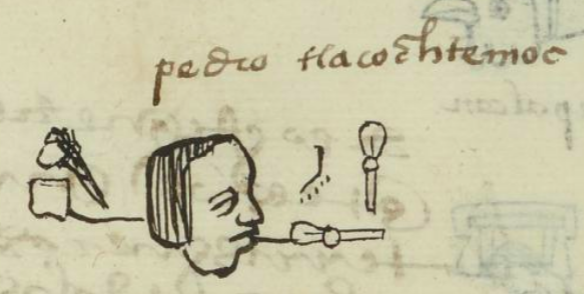Tlacochtemoc (MH525v)
This black-line drawing of the compound glyph for the personal name Tlacochtemoc (“The Arrow Descended,” attested here as a man’s name) shows the fletching ends of two projectiles (tlacochtli) and a footprint headed downward (recalling the verb to descend, temo). Each tlacochtli has a wing feather and a down feather, but no carved stone point.
Stephanie Wood
The omission of the point is not unusual in tlacochtli (or tlacochin) glyphs, and this is even true sometimes of other arrows or darts. The feather decorations are, however, similar to the acatl and mitl arrows. One wonders whether the spear or javelin without the point was a staff that was held by the Tlacochcalcatl. It may be relevant to explore possible connections between the names Tlacoch/Tlacochin and the title of the high judge or general, the Tlacochcalcatl.
A man named Tlacochintzin (with the reverential suffix) was a principal merchant in the time of Moquiuixtzin in Tlatelolco (central Mexico, sixteenth century). See: Fr. Bernardino de Sahagún, Florentine Codex: General History of the Things of New Spain; Book 9 -- The Merchants, No. 14, Part 10, eds. and transl. Arthur J. O. Anderson and Charles E. Dibble (Santa Fe and Salt Lake City: School of American Research and the University of Utah, 1959), 2.
pedro tlacochtemoc
Pedro Tlacochtemoc
Stephanie Wood
1560
Stephanie Wood
dardas, saetas, arrows, flechas, feathers, plumas, reeds, cañas, jabalinas, lanzas, huellas, huella, footprint, footprints, steps, step, paso, pasos, icximachiyotl, xocpalli, icxipamitl, nombres de hombres

tlacoch(tli), a projectile, such as an arrow, dart, spear, or javelin, https://nahuatl.wired-humanities.org/content/tlacochtli
temo, to descend, https://nahuatl.wired-humanities.org/content/temo
La Flecha Descendió, o La Flecha Bajó
Stephanie Wood
Matrícula de Huexotzinco, folio 525v, World Digital Library, https://www.loc.gov/resource/gdcwdl.wdl_15282/?sp=130&st=image.
This manuscript is hosted by the Library of Congress and the World Digital Library; used here with the Creative Commons, “Attribution-NonCommercial-ShareAlike 3.0 License” (CC-BY-NC-SAq 3.0).









